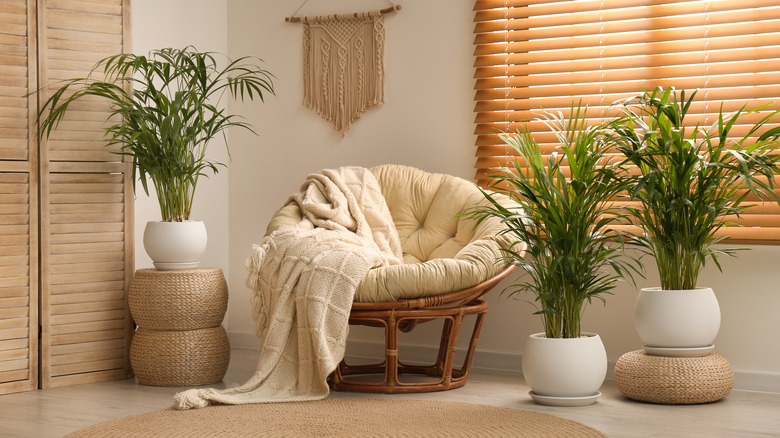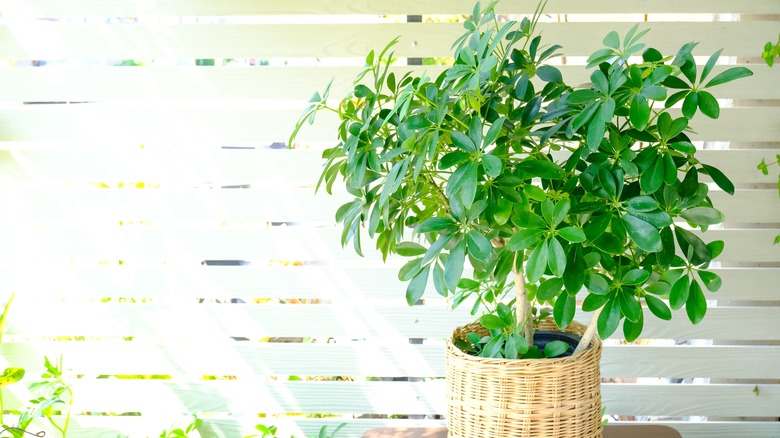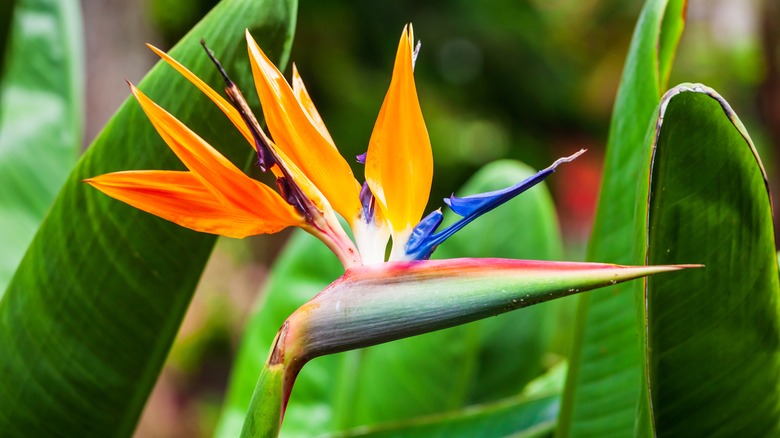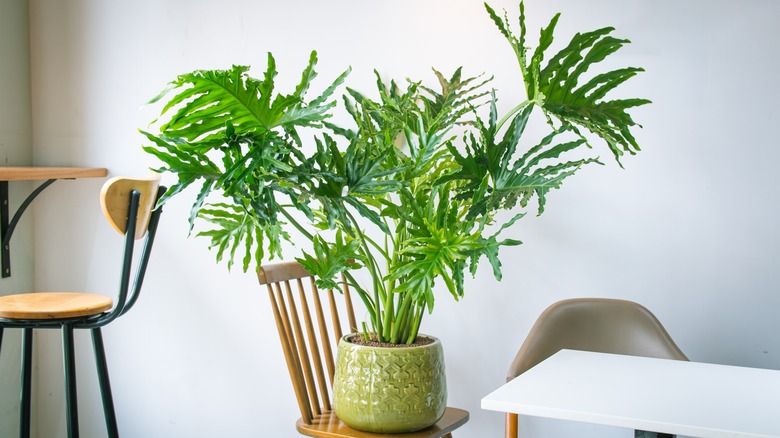The Best Statement House Plants To Own If You Don't Have A Green Thumb
If you are having consistent bad luck with house plants, you might think that means foregoing them completely — which is an unfortunate situation if you really love the look of plants in your home. However, most of the time, we are simply choosing the wrong type of plant for our home's climate or our lifestyle. Other times, it may be something as simple as overwatering or neglecting the plants that lead to their demise. Either way, there is no shortage of large and unique statement houseplants that are easy to grow indoors.
Gorgeous and eye-catching specimens are a great addition to any living space. They bring nature and life into an otherwise dull room. Even the most experienced gardeners turn to low-maintenance statement plants to decorate their homes. We selected a variety of well-loved trees, palms, and plants that can add drama to your rooms without a lot of work. Here are the best plants to begin growing some of the most amazing and lush greenery with ease.
Kentia palm
The Kentia palm (howea forsteriana), which is also sometimes called the paradise palm, is a tropical plant that is native to Howe Island off the eastern coast of Australia. When grown outdoors, the palm enjoys warm temperatures and a somewhat shady location, which is exactly what makes it such an easy-to-grow houseplant. The palm is known to survive even when exposed to dry heated hair, drought, and neglect. Consider positioning it out of direct sunlight and providing it with moderate watering.
Bamboo palm
The bamboo palm (dypsis lutescens), more commonly known as the areca palm, is an extremely popular houseplant. It requires average humidity and bright direct light, so it could be a good option to keep near a larger window. Bamboo palms are loved for their tall green stems with large fan-like leaves that certainly make a statement. As long as you keep your home relatively warm and humid, you should be able to grow this plant with ease.
Fiddle leaf fig
The fiddle leaf fig (ficus lyrata) is commonly grown indoors for its simple green leaves and tall growth habit. In their natural environment, the trees can grow more than 50 feet tall, however, they grow much smaller indoors. Native to the tropical regions of Africa, they prefer very warm weather, little water, and plenty of sunlight. Many home gardeners find it easy to replicate the tree's preferred climate which makes it quite simple to grow.
Dragon tree
Dragon trees (dracaena marginata) are known for their ability to grow happily indoors. Though they can take a while to grow tall enough to be considered a good statement plant, they do eventually grow up to 6 feet indoors with regular pruning. Dragon trees are tolerant of drought and neglect which makes them great plants for those without a green thumb. Simply plant it in well-draining soil and place it in an indirectly sunny location — before you know it, your tree will be showing off amazing foliage.
Umbrella tree
Umbrella trees, which are also known as schefflera plants (schefflera actinophylla), have unique umbrella-shaped leaf clusters. These are grown on tall and slender branches of the evergreen plant and they are quite showy. Grown as a houseplant, the umbrella tree must be pruned to stay at a reasonable height. They can reach upwards of 40 feet tall in warm and sunny climates that support their growing requirements. Indoors, make sure to provide yours with well-draining soil, moderate watering, and direct sunlight.
Money tree
A money tree (pachira aquatica) is a South American plant that is thought to bring fortune to its owner, which has aided in increasing its popularity. Also referred to as the Malabar chestnut tree, the houseplant normally reaches 6 to 8 feet tall despite growing more than 60 feet tall in its natural habitat. One of the most interesting aspects is its malleable stems that are frequently braided for more ornamental interest.
Pinstripe calathea
The calathea genus is known for its species that fold their foliage up and down as the day turns to night. The pinstripe calathea (calathea ornata) is no different, however, it is normally grown for its distinctive coloring and large growth habit instead of its folding leaves. It gets its name from its foliage that is very dark in color with thin stripes of white to pink color highlighting its veining. Grown as a houseplant, this calathea species is not too difficult to care for — it needs warm temperatures, high humidity, and plenty of water.
Majesty palm
The majesty palm (ravenea rivularis) is yet another tropical palm tree that can be grown with no difficulty indoors. It features similar foliage to the bamboo palm, with many green stems and arching leaves. This low-maintenance palm grows best in bright indirect sunlight when it's supplied with regular watering and above-average humidity. Additionally, you'll want to plant it in extremely well-draining soil — it likes water, but it should never be sitting in it for extended periods.
Bird of paradise plant
Bird of paradise (strelitzia reginae) is one of the most ornamental plants on this list. The flowers resemble a colorful tropical bird, hence the common name. Native to South Africa, this incredible houseplant needs only a little bit of regular maintenance. It enjoys direct and indirect sunlight, well-drained soil, and plenty of water. Still, as with most indoor plants, water your bird of paradise plant less in the winter while it's dormant.
Philodendron xanadu
Philodendron xanadu (thaumatophyllum xanadu 'winterbourn') is a lesser-known species that could make a unique addition to almost any room in your home. Keep in mind that the tropical plant does grow nearly as wide as it is tall — in maturity, it may reach 5 feet tall and wide. You should provide the winterbourn variety with bright indirect light, well-draining soil, and regular watering. It is regarded as easy to grow and good for beginner gardeners, so it may be the perfect statement plant for you.
Banana tree
If you're looking for a plant that is functional and beautiful, look no further than the banana tree (musa spp.). Most dwarf species of banana trees grow less than 13 feet tall, unlike their full-grown counterparts. Additionally, some species can actually produce small and edible bananas while supplying you with large ornamental leaves. All banana tree varieties need very similar care — they prefer direct sunlight, warm temperatures, and consistent watering.
Weeping fig
A relative of the fiddle leaf fig, the weeping fig (ficus benjamina) is also an easy-to-grow houseplant when you give it some sunlight and regular watering. Known to be low-maintenance, the weeping fig tree can tolerate some drought and neglect. Something that makes this fig such a great specimen as a statement plant is its malleable stems that can be trained into interesting shapes.
Fishtail palm
The fishtail palm (caryota mitis) is a unique palm species that gets its name from its foliage, which looks like a goldfish's tail. The triangular leaves are arranged in a spiral and normally measure about 6 inches in length. As a houseplant, the tree is very easy to grow, and enjoys full sun or full shade in well-drained, somewhat fertile soil. Fishtail palms grow well in containers indoors, even though they frequently reach more than 15 meters tall outdoors, they can be trained to fit in your living room.
Swiss cheese plant
Swiss cheese plants (monstera deliciosa) are certainly among the most well-known oversized houseplants. Plant lovers are drawn to this statement plant for its quirky foliage that is littered with splits and holes, giving it its common name. This monstera species grows quickly, so it will need to be repotted regularly, but it has very few maintenance needs otherwise. It is tolerant of a few different light conditions and humidity levels as it becomes older. As a young plant, it needs bright light, warm temperatures, and somewhat high humidity.
Cast iron plant
The cast iron plant (aspidistra elatior) is known for its low maintenance and tolerance to drought and shade. Frequently reaching 3 feet tall and 2 feet wide, it may be one of the easiest to care for. Cast iron plants are lovers of all things medium. They grow best in medium indirect light with average well-draining potting soil, and average room temperatures. This tough houseplant doesn't ask for much, but it still provides you with large glossy leaves that make it wonderfully ornamental.
Snake plant
Snake plants (dracaena trifasciata) are often sold when they are less than 2 feet tall, but their leaves can grow up to 4 feet quite rapidly. This eccentric houseplant is known for its easy-to-grow nature. When placed in indirect sunlight indoors, a snake plant shouldn't need more than a little water now and again.
Dumbcane plant
Dieffenbachia (dieffenbachia spp.), also called the dumbcane plant, is a common houseplant grown for its height and ornamental leaves. Dieffenbachia leaves can be variegated in several different ways depending on the cultivar. Sometimes they are white with green edges, green with many white spots, or green with white veining. No matter which dieffenbachia variety you prefer, make sure to grow yours in bright indirect light, well-draining soil, and temperatures above 60 degrees Fahrenheit. Also, allow its soil to dry out completely between watering.
Horsehead philodendron
Horsehead philodendron (philodendron bipinnatifidum) is a South American plant that looks quite similar to the swiss cheese plant. With large and dissected leaves, it's not hard to believe that the two plants are a part of the same family. This philodendron, however, is non-climbing and it should not be grown in direct sunlight. It tends to enjoy moist soil and warm temperatures around 70 degrees Fahrenheit. With good care, the horsehead philodendron could become a large and interesting statement plant for your home.
Spineless yucca
Spineless yucca plants (yucca elephantipes) are the tallest yucca species, normally growing nearly 30 feet tall in their natural environment. Native to Mexico and Guatemala, the plants need high temperatures and little water to survive. They make for great container plants and are usually easier to care for indoors where the climate is controlled. A spineless yucca tree is a great option for those who live in drier climates with low humidity, it also is great for beginner gardeners as it needs no pruning or a regular watering schedule.
Rubber tree
Rubber trees (ficus elastica) are members of the fig tree family. Their large leaves can have markings that are white, red, pink, or gold depending on the cultivar. People like using rubber trees as statement plants around their homes as they are not too fussy about their growing environment. In all, these plants need some indirect light, normal room temperatures, and limited watering. Although they grow best in east-facing windows with some humidity, they are quite adaptable to dry air and shadier locations.




















